Petrophysical Database for European Pegmatite Exploration—EuroPeg
Abstract
1. Introduction
2. Sample Collection
2.1. Austria
2.2. Ireland
2.3. Norway
2.4. Portugal and Spain
3. Petrophysical Measurements
3.1. Laboratory Analysis
3.2. Handheld Measurements
3.3. Geophysical Borehole Logging
3.3.1. Petrophysical Data from Borehole Logging over Core Sample Intervals
3.3.2. Petrophysical Data from Borehole Logging over Lithological Units
4. Results
4.1. Database
4.1.1. Meta-Information
4.1.2. Confidentiality or Restrictions
4.1.3. Format, Access, and Versioning
4.2. Application Examples
5. Discussion
Author Contributions
Funding
Data Availability Statement
Acknowledgments
Conflicts of Interest
References
- European Commission. Critical Raw Materials. Available online: https://single-market-economy.ec.europa.eu/sectors/raw-materials/areas-specific-interest/critical-raw-materials_en (accessed on 20 November 2022).
- Bradley, D.C.; McCauley, A.D.; Stillings, L.M. Mineral-Deposit Model for Lithium-Cesium-Tantalum Pegmatites; U.S. Geological Survey Scientific Investigations Report 2010–5070–O; US Geological Survey: Reston, VA, USA, 2017; 48p. [CrossRef]
- Galeschuk, C.; Vanstone, P. Exploration Techniques for Rare-Element Pegmatite in the Bird River Greenstone Belt, Southeastern Manitoba. In Proceedings of the Exploration 07: Fifth Decennial International Conference on Mineral Exploration, Toronto, ON, Canada, 9–12 September 2007; Milkereit, B., Ed.; pp. 823–883. [Google Scholar]
- Steiner, B.M. Tools and Workflows for Grassroots Li–Cs–Ta (LCT) Pegmatite Exploration. Minerals 2019, 9, 499. [Google Scholar] [CrossRef]
- Trueman, D.L.; Černý, P. Exploration for Rare-Element Granitic Pegmatites. In Granitic Pegmatites in Science and Industry: Mineralogical Association of Canada, Short Course Handbook; Černý, P., Ed.; Mineralogical Association of Canada: Quebec, QC, Canada, 1982; Volume 8, pp. 463–493. [Google Scholar]
- Gupta, V.K.; Wadge, D.R. Gravity study of the Birch, Uchi, and Red lakes area, District of Kenora (Patricia Portion); Ontario Geological Survey, Report 252; Ontario Ministry of Northern Development and Mines: Sudbury, ON, Canada, 1986; 98p.
- Eberle, D.G.; Daudi, E.X.F.; Muiuane, E.A.; Nyabeze, P.; Pontavida, A.M. Crisp clustering of airborne geophysical data from the Alto Ligonha pegmatite field, northeastern Mozambique, to predict zones of increased rare earth element potential. J. Afr. Earth Sci. 2012, 62, 26–34. [Google Scholar] [CrossRef]
- McKechnie, C.L.; Annesley, I.R.; Ansdell, K.M. Geological Setting, Petrology, and Geochemistry of Granitic Pegmatites and Leucogranites Hosting U-Th-REE Mineralization at Fraser Lakes Zone B, Wollaston Domain, Northern Saskatchewan, Canada. Explor. Min. Geol. 2013, 21, 1–26. [Google Scholar]
- Ahtola, T.; Kuusela, J.; Käpyaho, A.; Kontoniemi, O. (Eds.) Overview of Lithium Pegmatite Exploration in the Kaustinen Area in 2003–2012; Geological Survey of Finland, Report of Investigation; Geological Survey of Finland: Espoo, Finland, 2015; Volume 220, 28p. [Google Scholar]
- Müller, A.; Reimer, W.; Wall, F.; Williamson, B.; Menuge, J.; Brönner, M.; Haase, C.; Brauch, K.; Pohl, C.; Lima, A.; et al. GREENPEG—Exploration for Pegmatite Minerals to Feed the Energy Transition: First Steps towards the Green Stone Age; Geological Society: London, UK, 2022; Volume 526. [Google Scholar] [CrossRef]
- Černý, P. Rare-element granitic pegmatites. Part I: Anatomy and internal evolution of pegmatite deposits. Geosci. Can. 1991, 18, 49–81. [Google Scholar]
- Bär, K.; Reinsch, T.; Bott, J. The PetroPhysical Property Database (P3)—A global compilation of lab-measured rock properties. Earth Syst. Sci. Data 2020, 12, 2485–2515. [Google Scholar] [CrossRef]
- Haase, C.; Brönner, M.; Pohl, C.M.; Osinska, M.; Gellein, J. EuroPeg_PetroDB: A Petrophysical Database of European Pegmatite Ores and Wall Rocks; NGU Report 2022.017; Geological Survey of Norway: Trondheim, Norway, 2022; 15p. [Google Scholar]
- Göd, R. The spodumene deposit at “Weinebene”, Koralpe, Austria. Mineral. Depos. 1989, 24, 270–278. [Google Scholar] [CrossRef]
- Hart, E.; Fegan, T. PL 4032 Review Report, Work Conducted between August 2019 and June 2021; Blackstairs Lithium Ltd.: County Wicklow, Ireland, 2021; 70p. [Google Scholar]
- Barros, R.; Kaeter, D.; Menuge, J.F.; Skoda, R. Controls on chemical evolution and rare element enrichment in crystallising albite-spodumene pegmatite and wallrocks: Constraints from mineral chemistry. Lithos 2020, 352–353, 105289. [Google Scholar] [CrossRef]
- Müller, A.; Husdal, T.; Sunde, Ø.; Friis, H.; Andersen, T.; Johnsen, T.; Werner, R.; Thoresen, Ø.; Olerud, S. Norwegian Pegmatites I: Tysfjord-Hamarøy, Evje-Iveland, Langesundsfjord. Geological Guides 6; Geological Society of Norway: Trondheim, Norway, 2017; 125p, ISBN 978-82-8347-020-8. [Google Scholar]
- Roda-Robles, E.; Villaseca, C.; Pesquera, A.; Gil-Crespo, P.P.; Vieira, R.; Lima, A.; Garate-Olave, I. Petrogenetic relationships between Variscan granitoids and Li-(F-P)-rich aplite-pegmatites in the Central Iberian Zone: Geological and geochemical constraints and implications for other regions from the European Variscides. Ore Geol. Rev. 2018, 95, 408–430. [Google Scholar] [CrossRef]
- Koziel, J. (Geological Survey of Norway, Trondheim, Norway). Personal communication, 2022.
- Haase, C.; Brönner, M.; Pohl, C.; Osinska, M.; Gellein, J. EuroPeg_PetroDB: A petrophysical database of European pegmatite ores and wall rocks, (1.0) [Data set]. Zenodo, 2022. [Google Scholar] [CrossRef]
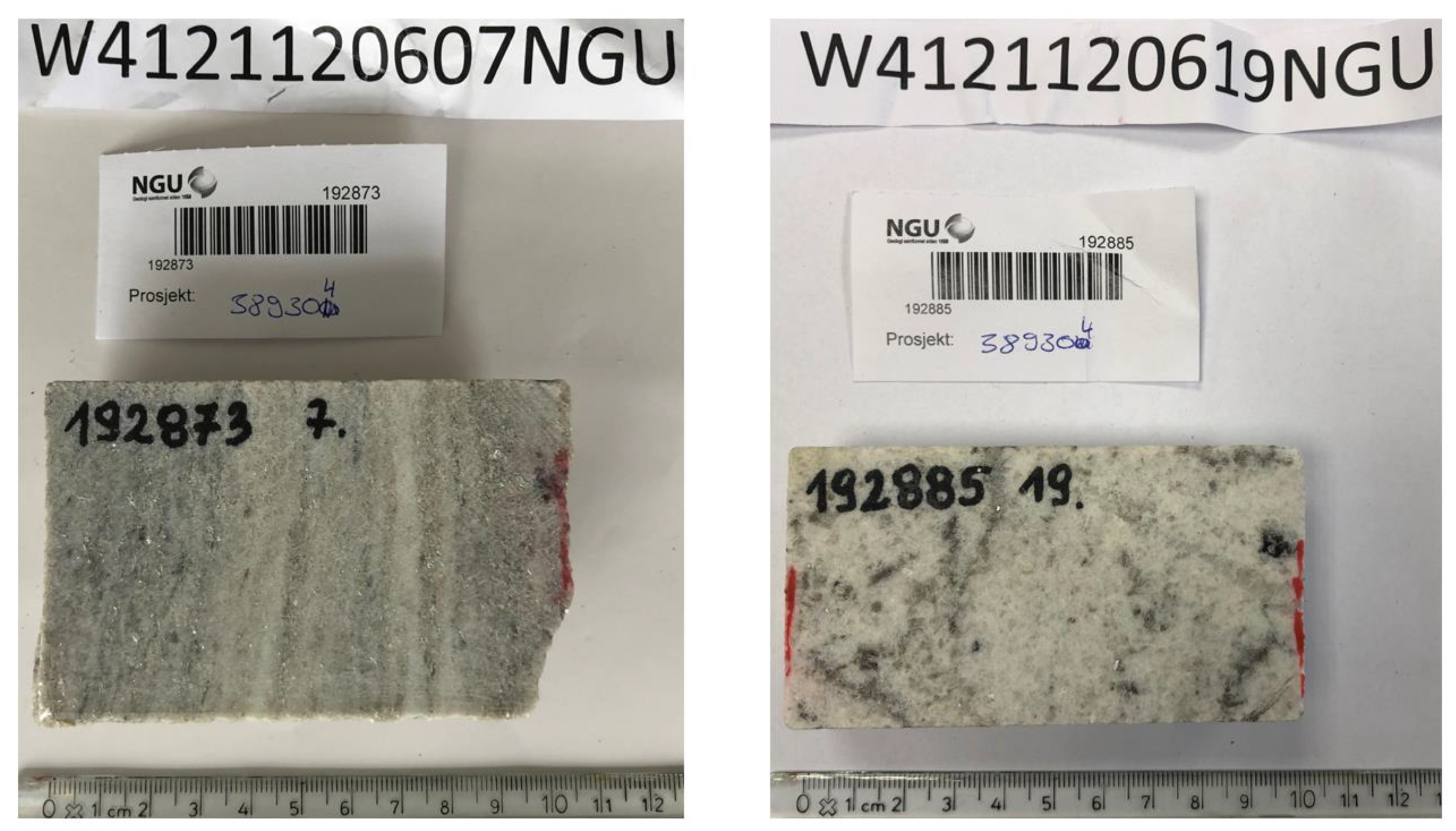


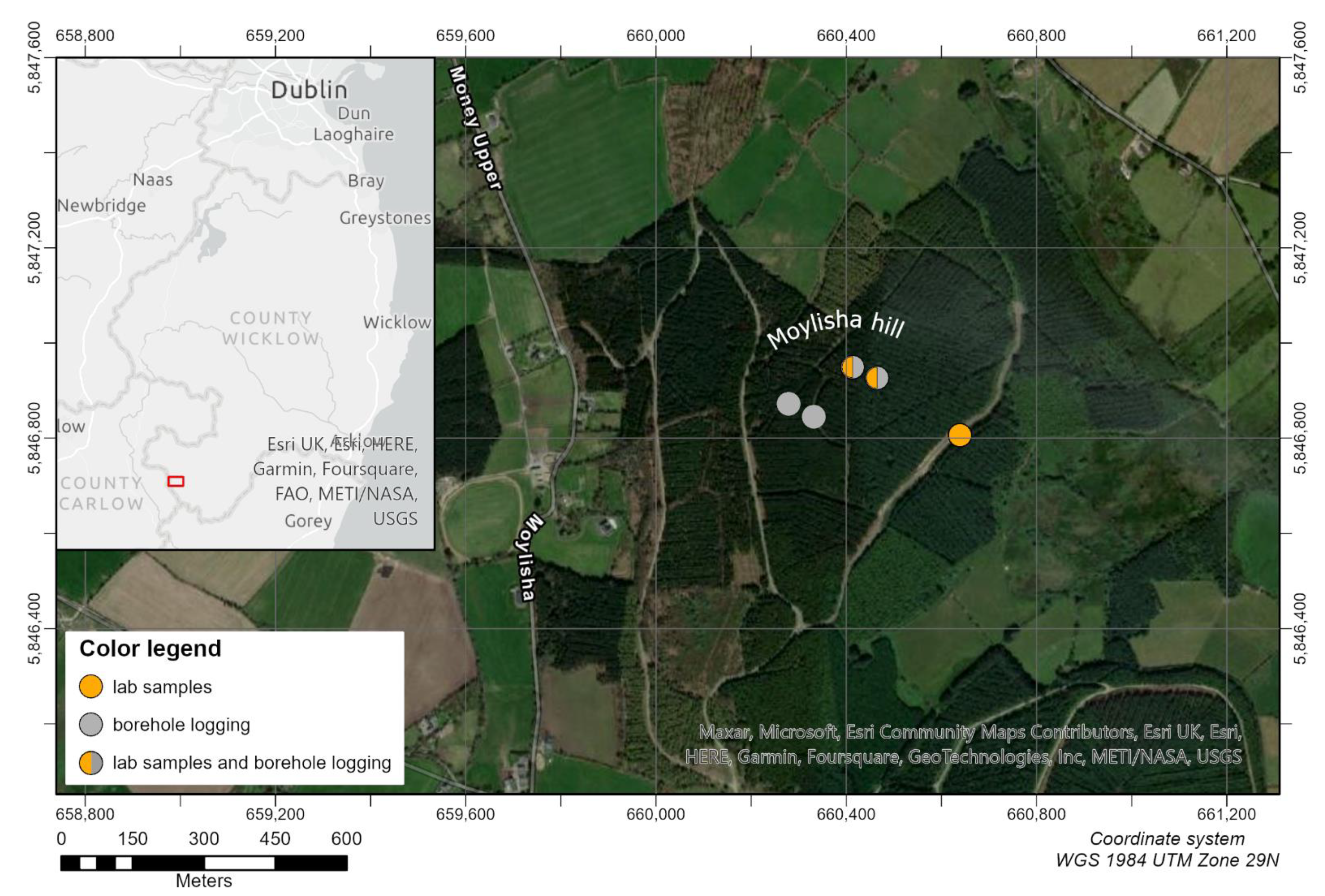


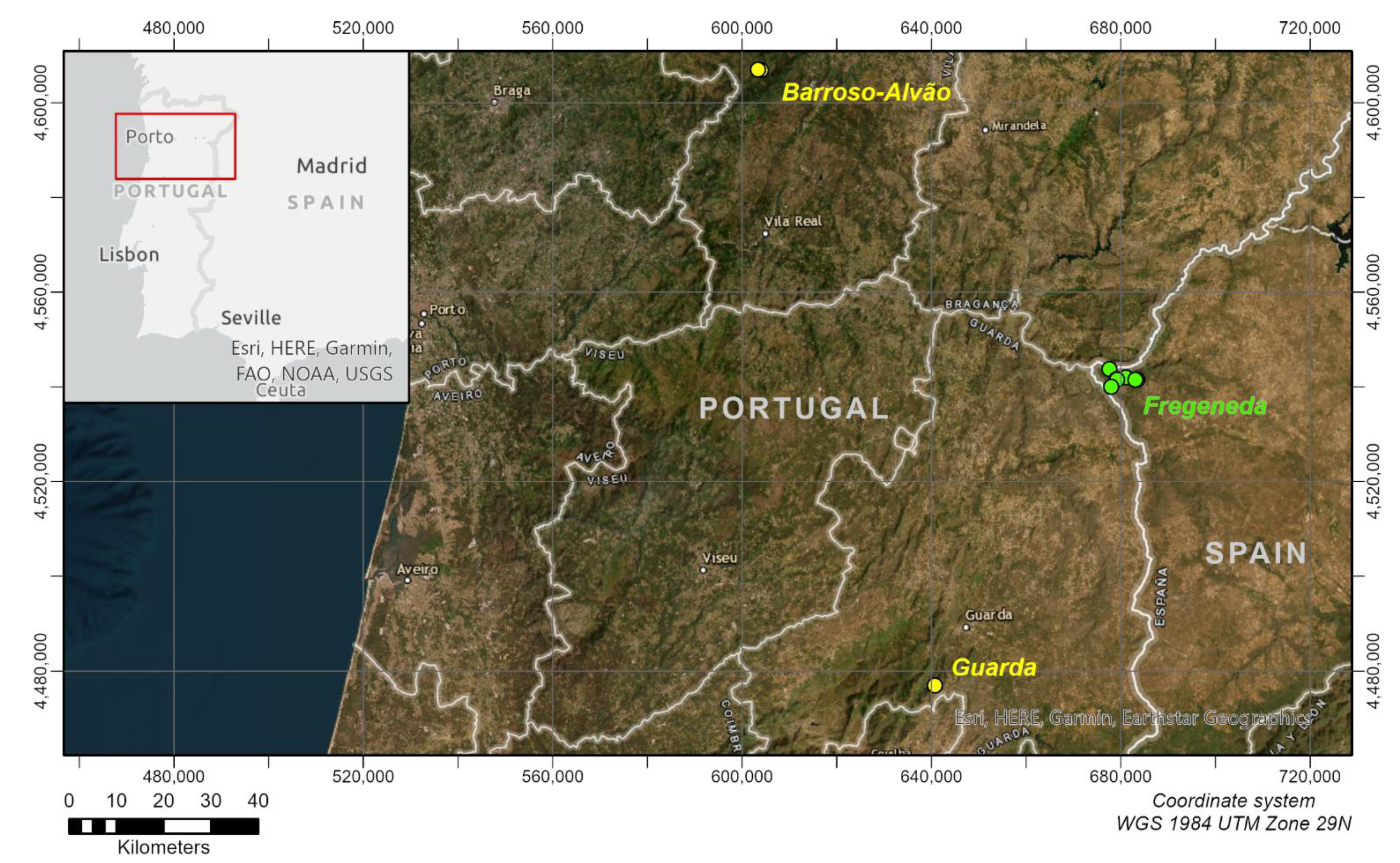
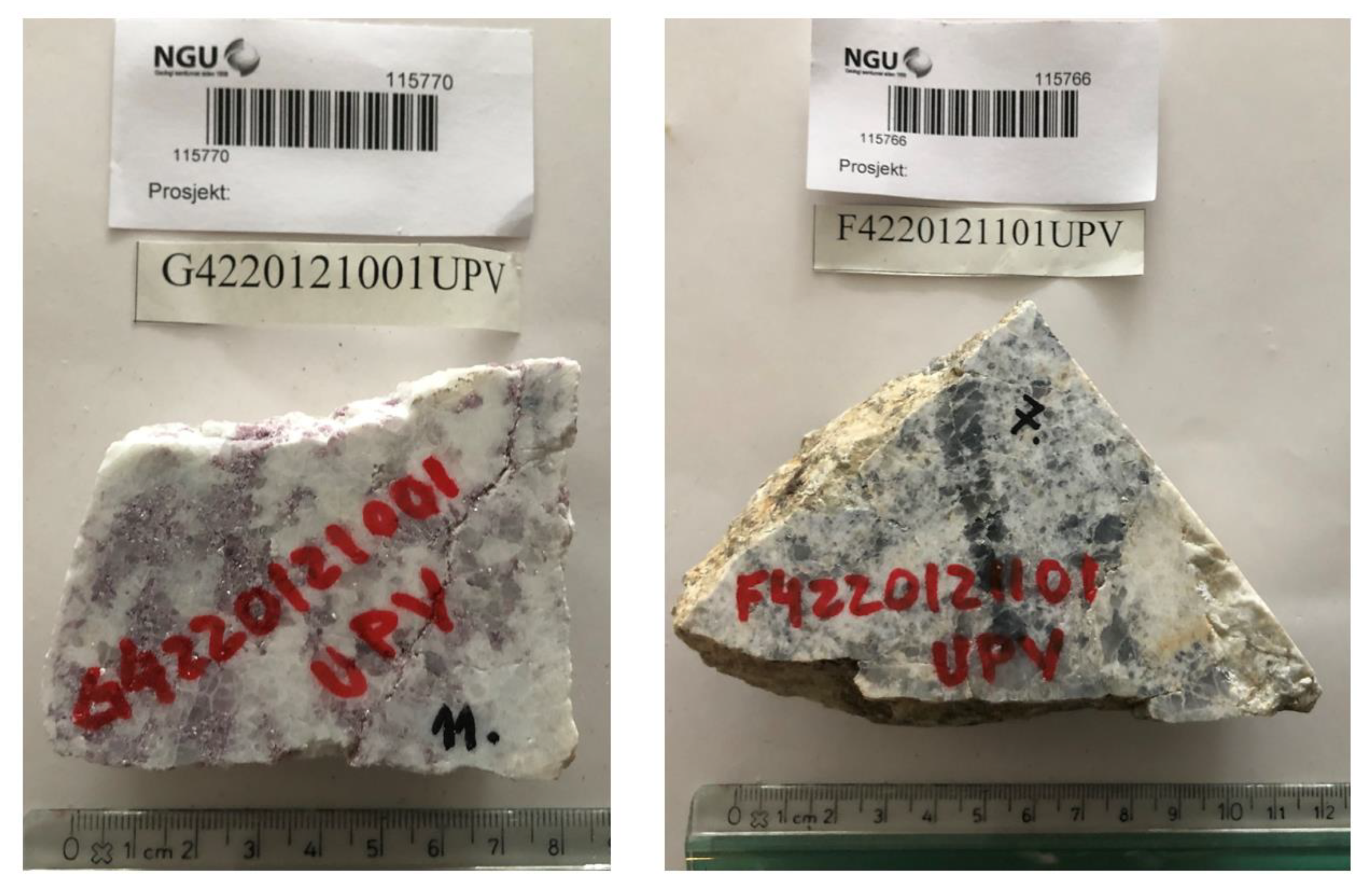
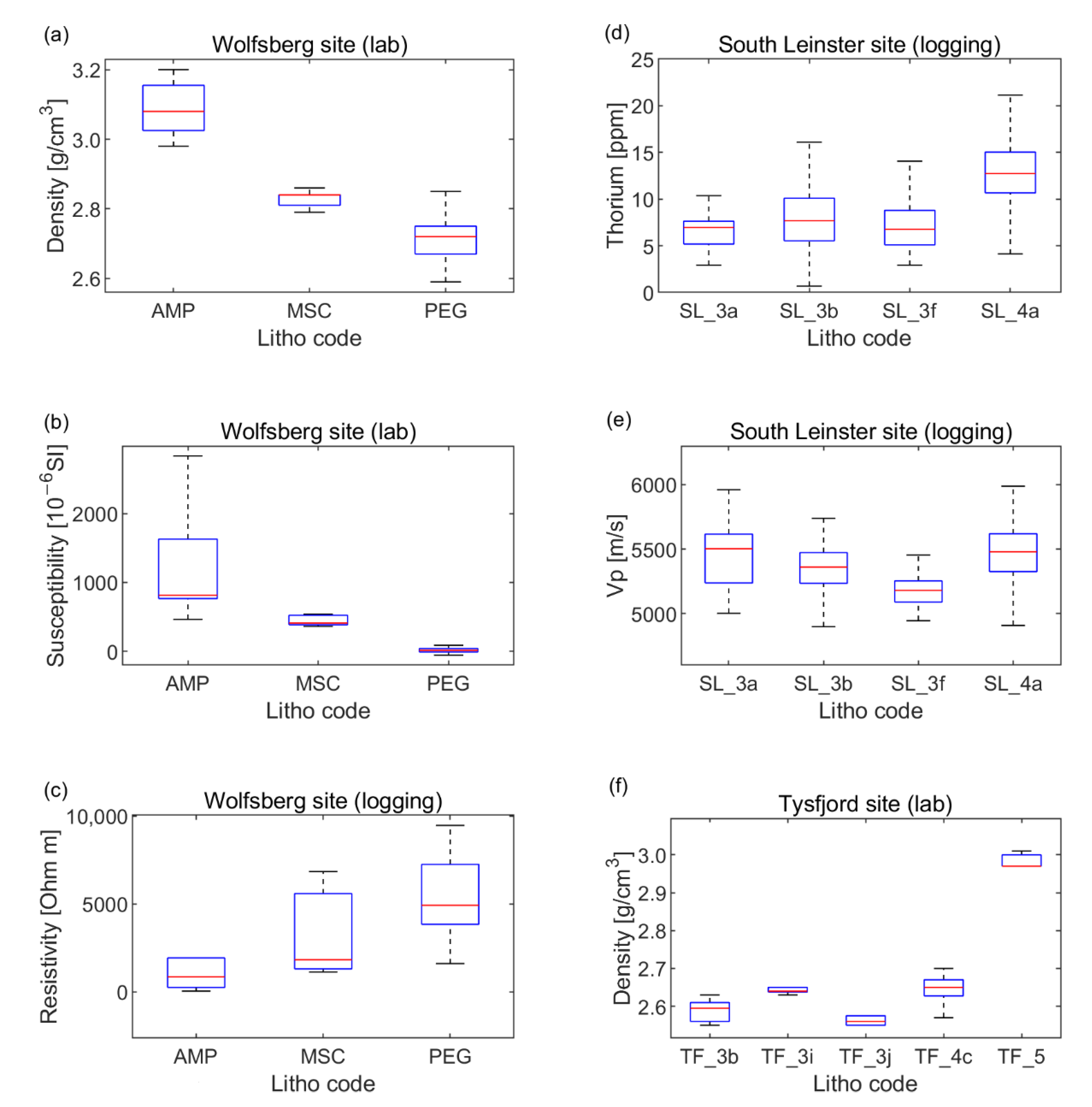
| Property | Measuring Range | Relative Uncertainty (%) |
|---|---|---|
| Magnetic susceptibility (10−6 SI) | <100 | 60 |
| 100–1000 | 6 | |
| 1000–100,000 | 0.6 | |
| >100,000 | 0.1 | |
| Magnetic remanence (mA/m) | <140,000 | 7.5 |
| Probe | Manufacturer | Parameter Used for Database | Sample Rate |
|---|---|---|---|
| Dual Induction (DIL38) | LIM LOGGING SA, Luxembourg | Formation conductivity, long-spaced receiver coils | 1 cm |
| Uranium Exploration (UEP42) | LIM LOGGING SA, Luxembourg | Formation resistivity, Chargeability | 1 cm |
| Magsus (QL40-MGS) | ALT—Advanced Logic Technology, Luxembourg | Magnetic susceptibility | 1 cm |
| Spectral Gamma (GRS42) | LIM LOGGING SA, Luxembourg | Spectral Gamma Ray (K2O, U3O8, ThO2-content) | 10 cm |
| Full Wave Form Sonic (QL40-FWS) | ALT—Advanced Logic Technology, Luxembourg | Full Wave Form Sonic (Vp, Vs, Vp/Vs Ratio, Poisson’s Ratio, Shear Modulus *, Young’s Modulus *, Bulk Modulus *), total count natural Gamma Ray | 5 cm |
Publisher’s Note: MDPI stays neutral with regard to jurisdictional claims in published maps and institutional affiliations. |
© 2022 by the authors. Licensee MDPI, Basel, Switzerland. This article is an open access article distributed under the terms and conditions of the Creative Commons Attribution (CC BY) license (https://creativecommons.org/licenses/by/4.0/).
Share and Cite
Haase, C.; Pohl, C.M. Petrophysical Database for European Pegmatite Exploration—EuroPeg. Minerals 2022, 12, 1498. https://doi.org/10.3390/min12121498
Haase C, Pohl CM. Petrophysical Database for European Pegmatite Exploration—EuroPeg. Minerals. 2022; 12(12):1498. https://doi.org/10.3390/min12121498
Chicago/Turabian StyleHaase, Claudia, and Claudia M. Pohl. 2022. "Petrophysical Database for European Pegmatite Exploration—EuroPeg" Minerals 12, no. 12: 1498. https://doi.org/10.3390/min12121498
APA StyleHaase, C., & Pohl, C. M. (2022). Petrophysical Database for European Pegmatite Exploration—EuroPeg. Minerals, 12(12), 1498. https://doi.org/10.3390/min12121498





